Ahmed Alaa
Hybrid Meta-learners for Estimating Heterogeneous Treatment Effects
Jun 16, 2025Abstract:Estimating conditional average treatment effects (CATE) from observational data involves modeling decisions that differ from supervised learning, particularly concerning how to regularize model complexity. Previous approaches can be grouped into two primary "meta-learner" paradigms that impose distinct inductive biases. Indirect meta-learners first fit and regularize separate potential outcome (PO) models and then estimate CATE by taking their difference, whereas direct meta-learners construct and directly regularize estimators for the CATE function itself. Neither approach consistently outperforms the other across all scenarios: indirect learners perform well when the PO functions are simple, while direct learners outperform when the CATE is simpler than individual PO functions. In this paper, we introduce the Hybrid Learner (H-learner), a novel regularization strategy that interpolates between the direct and indirect regularizations depending on the dataset at hand. The H-learner achieves this by learning intermediate functions whose difference closely approximates the CATE without necessarily requiring accurate individual approximations of the POs themselves. We demonstrate empirically that intentionally allowing suboptimal fits to the POs improves the bias-variance tradeoff in estimating CATE. Experiments conducted on semi-synthetic and real-world benchmark datasets illustrate that the H-learner consistently operates at the Pareto frontier, effectively combining the strengths of both direct and indirect meta-learners.
ER-REASON: A Benchmark Dataset for LLM-Based Clinical Reasoning in the Emergency Room
May 28, 2025Abstract:Large language models (LLMs) have been extensively evaluated on medical question answering tasks based on licensing exams. However, real-world evaluations often depend on costly human annotators, and existing benchmarks tend to focus on isolated tasks that rarely capture the clinical reasoning or full workflow underlying medical decisions. In this paper, we introduce ER-Reason, a benchmark designed to evaluate LLM-based clinical reasoning and decision-making in the emergency room (ER)--a high-stakes setting where clinicians make rapid, consequential decisions across diverse patient presentations and medical specialties under time pressure. ER-Reason includes data from 3,984 patients, encompassing 25,174 de-identified longitudinal clinical notes spanning discharge summaries, progress notes, history and physical exams, consults, echocardiography reports, imaging notes, and ER provider documentation. The benchmark includes evaluation tasks that span key stages of the ER workflow: triage intake, initial assessment, treatment selection, disposition planning, and final diagnosis--each structured to reflect core clinical reasoning processes such as differential diagnosis via rule-out reasoning. We also collected 72 full physician-authored rationales explaining reasoning processes that mimic the teaching process used in residency training, and are typically absent from ER documentation. Evaluations of state-of-the-art LLMs on ER-Reason reveal a gap between LLM-generated and clinician-authored clinical reasoning for ER decisions, highlighting the need for future research to bridge this divide.
Model Editing with Graph-Based External Memory
May 23, 2025Abstract:Large language models (LLMs) have revolutionized natural language processing, yet their practical utility is often limited by persistent issues of hallucinations and outdated parametric knowledge. Although post-training model editing offers a pathway for dynamic updates, existing methods frequently suffer from overfitting and catastrophic forgetting. To tackle these challenges, we propose a novel framework that leverages hyperbolic geometry and graph neural networks for precise and stable model edits. We introduce HYPE (HYperbolic Parameter Editing), which comprises three key components: (i) Hyperbolic Graph Construction, which uses Poincar\'e embeddings to represent knowledge triples in hyperbolic space, preserving hierarchical relationships and preventing unintended side effects by ensuring that edits to parent concepts do not inadvertently affect child concepts; (ii) M\"obius-Transformed Updates, which apply hyperbolic addition to propagate edits while maintaining structural consistency within the hyperbolic manifold, unlike conventional Euclidean updates that distort relational distances; and (iii) Dual Stabilization, which combines gradient masking and periodic GNN parameter resetting to prevent catastrophic forgetting by focusing updates on critical parameters and preserving long-term knowledge. Experiments on CounterFact, CounterFact+, and MQuAKE with GPT-J and GPT2-XL demonstrate that HYPE significantly enhances edit stability, factual accuracy, and multi-hop reasoning.
Norm Growth and Stability Challenges in Localized Sequential Knowledge Editing
Feb 26, 2025Abstract:This study investigates the impact of localized updates to large language models (LLMs), specifically in the context of knowledge editing - a task aimed at incorporating or modifying specific facts without altering broader model capabilities. We first show that across different post-training interventions like continuous pre-training, full fine-tuning and LORA-based fine-tuning, the Frobenius norm of the updated matrices always increases. This increasing norm is especially detrimental for localized knowledge editing, where only a subset of matrices are updated in a model . We reveal a consistent phenomenon across various editing techniques, including fine-tuning, hypernetwork-based approaches, and locate-and-edit methods: the norm of the updated matrix invariably increases with successive updates. Such growth disrupts model balance, particularly when isolated matrices are updated while the rest of the model remains static, leading to potential instability and degradation of downstream performance. Upon deeper investigations of the intermediate activation vectors, we find that the norm of internal activations decreases and is accompanied by shifts in the subspaces occupied by these activations, which shows that these activation vectors now occupy completely different regions in the representation space compared to the unedited model. With our paper, we highlight the technical challenges with continuous and localized sequential knowledge editing and their implications for maintaining model stability and utility.
Generalized Venn and Venn-Abers Calibration with Applications in Conformal Prediction
Feb 08, 2025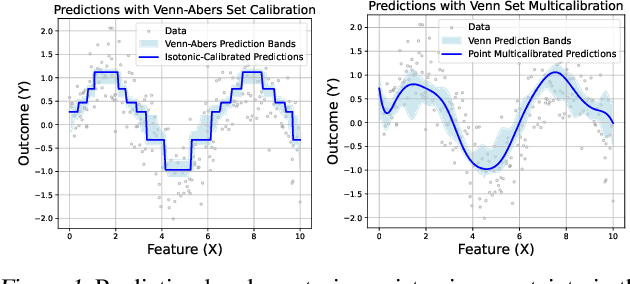
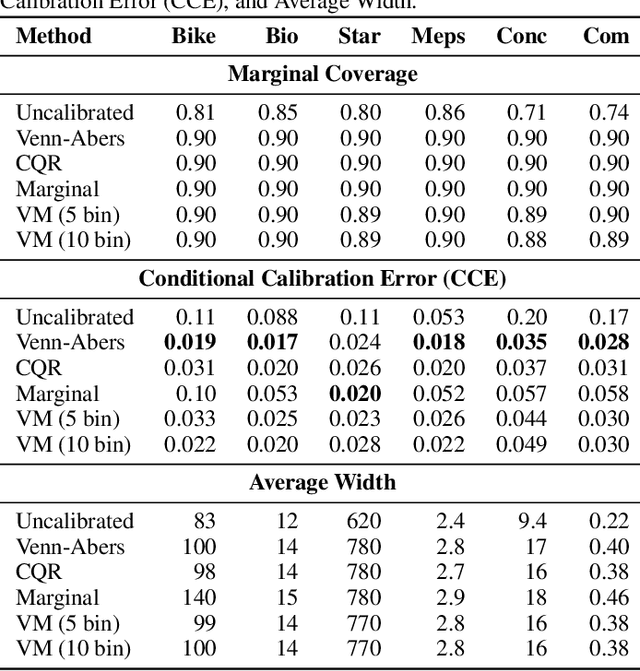
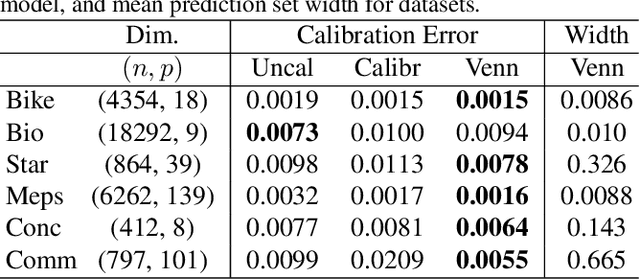
Abstract:Ensuring model calibration is critical for reliable predictions, yet popular distribution-free methods, such as histogram binning and isotonic regression, provide only asymptotic guarantees. We introduce a unified framework for Venn and Venn-Abers calibration, generalizing Vovk's binary classification approach to arbitrary prediction tasks and loss functions. Venn calibration leverages binning calibrators to construct prediction sets that contain at least one marginally perfectly calibrated point prediction in finite samples, capturing epistemic uncertainty in the calibration process. The width of these sets shrinks asymptotically to zero, converging to a conditionally calibrated point prediction. Furthermore, we propose Venn multicalibration, a novel methodology for finite-sample calibration across subpopulations. For quantile loss, group-conditional and multicalibrated conformal prediction arise as special cases of Venn multicalibration, and Venn calibration produces novel conformal prediction intervals that achieve quantile-conditional coverage. As a separate contribution, we extend distribution-free conditional calibration guarantees of histogram binning and isotonic calibration to general losses.
Limitations of Large Language Models in Clinical Problem-Solving Arising from Inflexible Reasoning
Feb 05, 2025Abstract:Large Language Models (LLMs) have attained human-level accuracy on medical question-answer (QA) benchmarks. However, their limitations in navigating open-ended clinical scenarios have recently been shown, raising concerns about the robustness and generalizability of LLM reasoning across diverse, real-world medical tasks. To probe potential LLM failure modes in clinical problem-solving, we present the medical abstraction and reasoning corpus (M-ARC). M-ARC assesses clinical reasoning through scenarios designed to exploit the Einstellung effect -- the fixation of thought arising from prior experience, targeting LLM inductive biases toward inflexible pattern matching from their training data rather than engaging in flexible reasoning. We find that LLMs, including current state-of-the-art o1 and Gemini models, perform poorly compared to physicians on M-ARC, often demonstrating lack of commonsense medical reasoning and a propensity to hallucinate. In addition, uncertainty estimation analyses indicate that LLMs exhibit overconfidence in their answers, despite their limited accuracy. The failure modes revealed by M-ARC in LLM medical reasoning underscore the need to exercise caution when deploying these models in clinical settings.
Lifelong Sequential Knowledge Editing without Model Degradation
Feb 03, 2025Abstract:Prior work in parameter-modifying knowledge editing has shown that large-scale sequential editing leads to significant model degradation. In this paper, we study the reasons behind this and scale sequential knowledge editing to 10,000 sequential edits, while maintaining the downstream performance of the original model. We first show that locate-then-edit knowledge editing methods lead to overfitting on the edited facts. We also show that continuous knowledge editing using these methods leads to disproportionate growth in the norm of the edited matrix. We then provide a crucial insight into the inner workings of locate-then-edit methods. We show that norm-growth is a hidden trick employed by these methods that gives larger importance to the output activations produced from the edited layers. With this "importance hacking", the edited layers provide a much larger contributions to the model's output. To mitigate these issues, we present ENCORE - Early stopping and Norm-Constrained Robust knowledge Editing. ENCORE controls for overfitting and the disproportionate norm-growth to enable long-term sequential editing, where we are able to perform up to 10,000 sequential edits without loss of downstream performance. ENCORE is also 61% faster than MEMIT and 64% faster than AlphaEdit on Llama3-8B.
Conformal Prediction Sets with Improved Conditional Coverage using Trust Scores
Jan 17, 2025
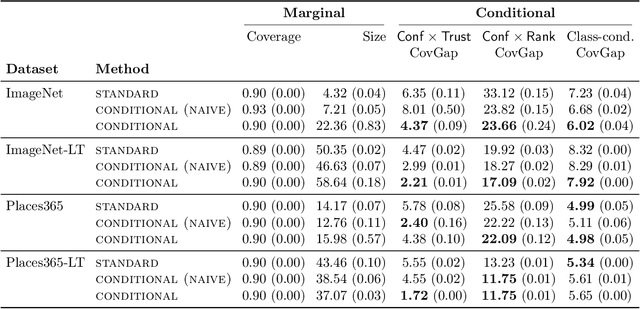


Abstract:Standard conformal prediction offers a marginal guarantee on coverage, but for prediction sets to be truly useful, they should ideally ensure coverage conditional on each test point. Unfortunately, it is impossible to achieve exact, distribution-free conditional coverage in finite samples. In this work, we propose an alternative conformal prediction algorithm that targets coverage where it matters most--in instances where a classifier is overconfident in its incorrect predictions. We start by dissecting miscoverage events in marginally-valid conformal prediction, and show that miscoverage rates vary based on the classifier's confidence and its deviation from the Bayes optimal classifier. Motivated by this insight, we develop a variant of conformal prediction that targets coverage conditional on a reduced set of two variables: the classifier's confidence in a prediction and a nonparametric trust score that measures its deviation from the Bayes classifier. Empirical evaluation on multiple image datasets shows that our method generally improves conditional coverage properties compared to standard conformal prediction, including class-conditional coverage, coverage over arbitrary subgroups, and coverage over demographic groups.
BioAgents: Democratizing Bioinformatics Analysis with Multi-Agent Systems
Jan 10, 2025Abstract:Creating end-to-end bioinformatics workflows requires diverse domain expertise, which poses challenges for both junior and senior researchers as it demands a deep understanding of both genomics concepts and computational techniques. While large language models (LLMs) provide some assistance, they often fall short in providing the nuanced guidance needed to execute complex bioinformatics tasks, and require expensive computing resources to achieve high performance. We thus propose a multi-agent system built on small language models, fine-tuned on bioinformatics data, and enhanced with retrieval augmented generation (RAG). Our system, BioAgents, enables local operation and personalization using proprietary data. We observe performance comparable to human experts on conceptual genomics tasks, and suggest next steps to enhance code generation capabilities.
Veridical Data Science for Medical Foundation Models
Sep 15, 2024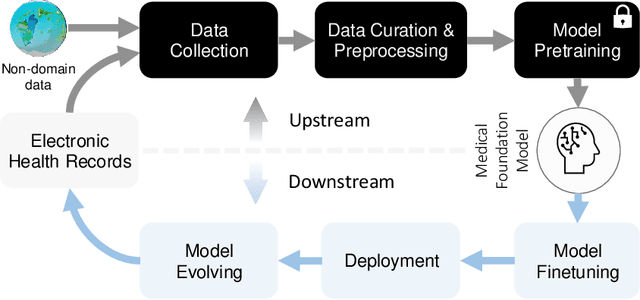
Abstract:The advent of foundation models (FMs) such as large language models (LLMs) has led to a cultural shift in data science, both in medicine and beyond. This shift involves moving away from specialized predictive models trained for specific, well-defined domain questions to generalist FMs pre-trained on vast amounts of unstructured data, which can then be adapted to various clinical tasks and questions. As a result, the standard data science workflow in medicine has been fundamentally altered; the foundation model lifecycle (FMLC) now includes distinct upstream and downstream processes, in which computational resources, model and data access, and decision-making power are distributed among multiple stakeholders. At their core, FMs are fundamentally statistical models, and this new workflow challenges the principles of Veridical Data Science (VDS), hindering the rigorous statistical analysis expected in transparent and scientifically reproducible data science practices. We critically examine the medical FMLC in light of the core principles of VDS: predictability, computability, and stability (PCS), and explain how it deviates from the standard data science workflow. Finally, we propose recommendations for a reimagined medical FMLC that expands and refines the PCS principles for VDS including considering the computational and accessibility constraints inherent to FMs.
 Add to Chrome
Add to Chrome Add to Firefox
Add to Firefox Add to Edge
Add to Edge